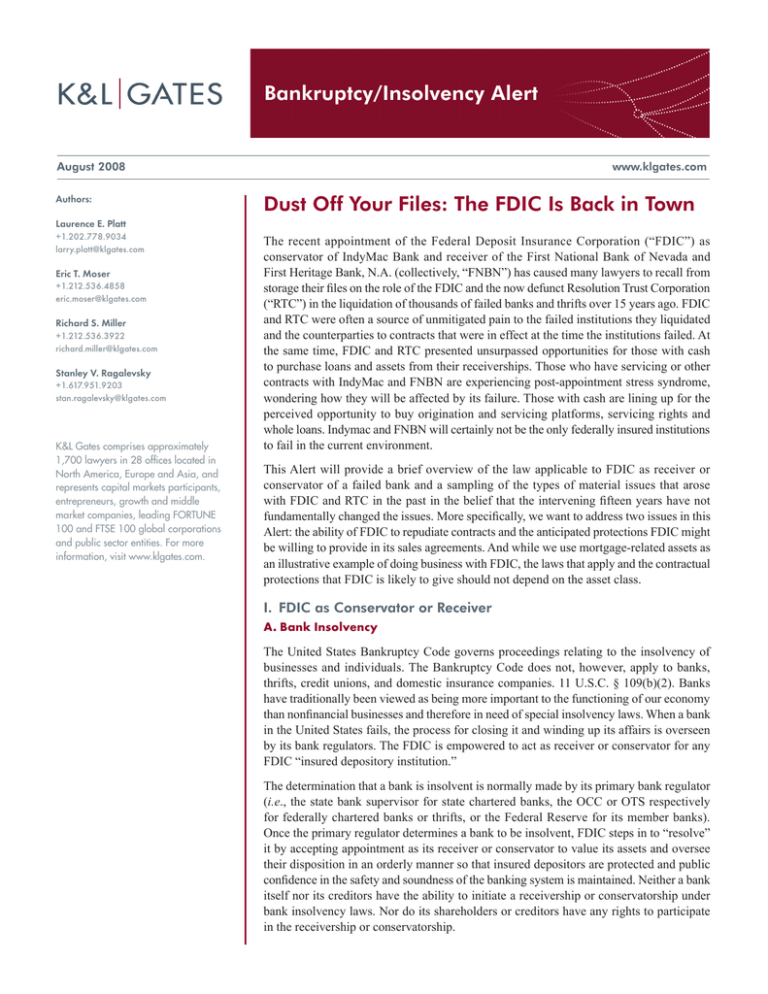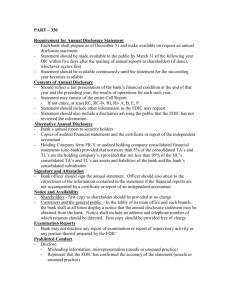
Bankruptcy/Insolvency Alert
August 2008
Authors:
www.klgates.com
Dust Off Your Files: The FDIC Is Back in Town
Laurence E. Platt
+1.202.778.9034
larry.platt@klgates.com
Eric T. Moser
+1.212.536.4858
eric.moser@klgates.com
Richard S. Miller
+1.212.536.3922
richard.miller@klgates.com
Stanley V. Ragalevsky
+1.617.951.9203
stan.ragalevsky@klgates.com
K&L Gates comprises approximately
1,700 lawyers in 28 offices located in
North America, Europe and Asia, and
represents capital markets participants,
entrepreneurs, growth and middle
market companies, leading FORTUNE
100 and FTSE 100 global corporations
and public sector entities. For more
information, visit www.klgates.com.
The recent appointment of the Federal Deposit Insurance Corporation (“FDIC”) as
conservator of IndyMac Bank and receiver of the First National Bank of Nevada and
First Heritage Bank, N.A. (collectively, “FNBN”) has caused many lawyers to recall from
storage their files on the role of the FDIC and the now defunct Resolution Trust Corporation
(“RTC”) in the liquidation of thousands of failed banks and thrifts over 15 years ago. FDIC
and RTC were often a source of unmitigated pain to the failed institutions they liquidated
and the counterparties to contracts that were in effect at the time the institutions failed. At
the same time, FDIC and RTC presented unsurpassed opportunities for those with cash
to purchase loans and assets from their receiverships. Those who have servicing or other
contracts with IndyMac and FNBN are experiencing post-appointment stress syndrome,
wondering how they will be affected by its failure. Those with cash are lining up for the
perceived opportunity to buy origination and servicing platforms, servicing rights and
whole loans. Indymac and FNBN will certainly not be the only federally insured institutions
to fail in the current environment.
This Alert will provide a brief overview of the law applicable to FDIC as receiver or
conservator of a failed bank and a sampling of the types of material issues that arose
with FDIC and RTC in the past in the belief that the intervening fifteen years have not
fundamentally changed the issues. More specifically, we want to address two issues in this
Alert: the ability of FDIC to repudiate contracts and the anticipated protections FDIC might
be willing to provide in its sales agreements. And while we use mortgage-related assets as
an illustrative example of doing business with FDIC, the laws that apply and the contractual
protections that FDIC is likely to give should not depend on the asset class.
I. FDIC as Conservator or Receiver
A.Bank Insolvency
The United States Bankruptcy Code governs proceedings relating to the insolvency of
businesses and individuals. The Bankruptcy Code does not, however, apply to banks,
thrifts, credit unions, and domestic insurance companies. 11 U.S.C. § 109(b)(2). Banks
have traditionally been viewed as being more important to the functioning of our economy
than nonfinancial businesses and therefore in need of special insolvency laws. When a bank
in the United States fails, the process for closing it and winding up its affairs is overseen
by its bank regulators. The FDIC is empowered to act as receiver or conservator for any
FDIC “insured depository institution.”
The determination that a bank is insolvent is normally made by its primary bank regulator
(i.e., the state bank supervisor for state chartered banks, the OCC or OTS respectively
for federally chartered banks or thrifts, or the Federal Reserve for its member banks).
Once the primary regulator determines a bank to be insolvent, FDIC steps in to “resolve”
it by accepting appointment as its receiver or conservator to value its assets and oversee
their disposition in an orderly manner so that insured depositors are protected and public
confidence in the safety and soundness of the banking system is maintained. Neither a bank
itself nor its creditors have the ability to initiate a receivership or conservatorship under
bank insolvency laws. Nor do its shareholders or creditors have any rights to participate
in the receivership or conservatorship.
Bankruptcy/Insolvency Alert
Upon appointment as receiver or conservator of a failed
bank, FDIC succeeds to all rights of the failed bank
and has the general authority to operate its business,
exercise all the failed bank’s corporate powers and
even merge it with another bank or transfer its assets
to a new “bridge bank” as occurred with IndyMac. 12
U.S.C. § 1821(d). FDIC, as receiver, has authority to
determine the validity of creditors’ claims of a failed
bank. 12 U.S.C. § 1821(d)(3). Following the passage
of the National Depositor Preference Amendment in
1993, all deposits in a failed bank (including uninsured
deposits) are given a statutory priority and preference
over other unsecured claims. This means that the
failed bank’s depositors will be paid before its general
unsecured creditors. In most FDIC receiverships, those
general unsecured creditors can expect to receive no
dividend on their unsecured claims.
B. Powers and Purposes of a Receiver1
Once appointed as receiver, FDIC has a number of
special powers to facilitate disposition of the failed
bank’s assets, including the power to:
1. repudiate burdensome contracts entered into
prior to its appointment within a “reasonable
time” after its appointment. 12 U.S.C. § 1821(e).
2. enforce any contract, other than for directors
and officers liability insurance or a depository
institution bond, irrespective of any clauses
purporting to authorize the termination, default,
acceleration, or other exercise of rights based
solely upon the failed bank’s insolvency or the
appointment of a conservator or receiver. 12
U.S.C. § 1821(e)(12).
3. request a stay of legal actions or proceedings
for 90 days. 12 U.S.C. § 1821(d)(12).
4. avoid fraudulent transfers made within five
years of its appointment if the transfer was made
to hinder, delay or defraud the failed bank, the
receiver, or any other federal banking agency. 12
U.S.C. § 1821(d)(17).
5. merge the failed bank with another insured
depository institution and transfer all of the failed
1 The powers accorded to FDIC as conservator are similar,
though the purposes of a conservatorship are slightly different.
Unlike a receivership, which is designed to liquidate a failed bank,
a conservatorship is intended to allow FDIC to continue operating
a distressed financial institution and to preserve, administer, and
protect its assets until it can be rehabilitated or closed.
institution’s assets and liabilities without the prior
approval of any contract counterparty, court, or
government agency. 12 U.S.C. § 1821(d)(2)(G).
6. allow, disallow, and settle claims against the
failed bank. 12 U.S.C. § 1821(d)(3).
7. marshal the failed bank’s assets and use the
proceeds to pay creditors in accordance with
the priority scheme established by 12 U.S.C.
§ 1821(d)(11).
8. liquidate the failed bank or transfer some or all
of its assets to an acquiring institution. 12 U.S.C.
§ 1821(d)(2)(E)-(G).
II.Repudiation of Contracts
A.Scope of Repudiation Rights
Among the wide-ranging powers granted to the FDIC,
it is the power to repudiate contracts that sends shivers
up the spines of counterparties to insured institutions.
Generally speaking, FDIC may repudiate or disaffirm
any contract to which a failed bank is a party if it:
(1) deems performance of the contract or lease to
be “burdensome”; and (2) finds that repudiation
would promote the orderly administration of the
receivership estate. 12 U.S.C. § 1821(e). FDIC’s
repudiation power is similar to – but broader than
-- the power of a debtor in possession or bankruptcy
trustee to reject burdensome executory contracts,
since the FDIC’s power is not necessarily limited to
executory contracts.
B. Effects of Repudiation
The repudiation of a contract by FDIC as receiver or
conservator terminates the failed bank’s obligation
to render any future performance required under the
contract. The FDIC’s power to repudiate a contract in
a bank receivership is a particularly potent weapon for
a number of reasons:
1. FDIC can repudiate a contract or lease by
letter to the affected counterparty without court
approval and with no prior notice.
2. In the traditional bankruptcy proceeding, only
“executory” contracts can be avoided by a trustee
in bankruptcy. FDIC can, however, repudiate
any contract it finds “burdensome.” This makes
it possible for FDIC to repudiate revolving lines
of credit, partially funded construction loans and
letters of credit.
August 2008 | 2
Bankruptcy/Insolvency Alert
3. The damages recoverable against FDIC for
repudiating a contract in a bank receivership
are limited to the counterparty’s actual direct,
compensatory damages. Consequential damages
for lost profits, punitive damages and pain and
suffering are barred. Furthermore, damages
against FDIC as receiver are generally cut off
under the “fixed and certain” rule set forth in
12 U.S.C. § 1821(e)(3)(A) as of the date of the
receivership. Any damage claim allowed by
the FDIC is paid in the form of a “receiver’s
certificate”. Since claims of unsecured creditors
are, under the 1993 National Depositor Preference
Amendment, subordinate to depositor claims, the
likelihood of a dividend being paid out on such a
certificate is remote.
of the QFC and enforcement of set off and netting
rights; provided, however, that the right to terminate
or liquidate the QFC is temporarily suspended from the
time the receiver is appointed until the earlier of: (i) the
time the counterparty receives notice that the contract
has been transferred; or (ii) 5:00 p.m. (ET) on the
business day following the date of the appointment of
the receiver. 12 U.S.C. § 1821(e)(10)(B)(i); (b) allows
FDIC to dispose of QFC’s only in a manner that will
preserve the counterparty’s cross-collateralization, set
off and netting rights; and (c) gives the counterparty a
more favorable measure of damages determined as of
the actual date of repudiation (and not appointment of
FDIC as receiver) and including cost of cover in the
event FDIC repudiates a QFC.
4. While a trustee in bankruptcy cannot reject one
part of a contract and assume the rest, in a bank
receivership, FDIC can bifurcate the respective
assets and liabilities in contracts by rejecting
unfunded commitments on construction loans and
suing the borrowers for funds advanced under the
notes prior to the date of the receivership.
D.Selected Issues Regarding Repudiation
FDIC uses its power to repudiate contracts frequently
and in a number of different contexts. Borrowers
frequently learn the hard way that their existing line
of credit, construction loan facility, or unsecured
letter of credit at a failed bank has been rejected as
of the receivership date. Vendors providing services
to a failed bank can be terminated abruptly with little
recourse. If, however, a vendor continues to provide the
same services to FDIC subsequent to the receivership,
it may have a priority administrative claim under 12
U.S.C. § 1821(e)(7)(B) and be paid for those services.
Loan participation agreements and intercreditor
agreements have previously been repudiated by FDIC
although current FDIC policy seems to be not to reject
such agreements.
C. Qualified Financial Contracts
A contract between a failed bank and a counterparty
that meets the definition of a “Qualified Financial
Contract” under 12 U.S.C. § 1821(e)(8)(D) receives
certain protections against the FDIC as receiver.
Qualified Financial Contracts (“QFC”) include a
“securities contract, forward contract, repurchase
agreement, swap agreement” or equivalent. These
special protections (a) allow counterparties to a QFC
with a failed bank to enforce provisions in their
agreements allowing the termination and liquidation
Questions abound about the scope and implications of
FDIC’s repudiation power. For example, is a secured
creditor at risk that its collateral will be stripped away,
effectively converting its secured obligation into an
unsecured one? Can a counterparty to a repo agreement
liquidate its position following the appointment of
a receiver as it could in a bankruptcy context? Is
a loan servicer at risk that its servicing agreement
will be unilaterally terminated without payment of a
termination fee? Will a loan servicer be reimbursed
for outstanding advances, and is the answer different
depending on whether the advances are made before or
after the appointment of a receiver? Should a servicer
continue to advance under the servicing agreement
pending a determination by the conservator regarding
whether to repudiate?
While the purpose of this alert is not to write a treatise
on the powers of FDIC as conservator or receiver, there
are some important points to highlight.
1. FDIC is limited in its ability to repudiate
secured loans. It cannot avoid a legally
enforceable and perfected security interests,
unless the interest was taken in contemplation
of the institution’s insolvency or with the intent
to “hinder, delay, or defraud” the institution or
its creditors. 12 U.S.C. § 1821(e)(11); see also
FDIC Statement of Policy Regarding Treatment
of Security Interests After Appointment of
The Federal Deposit Insurance Corporation As
Conservator Or Receiver, 58 Fed. Reg. 16833,
March 31, 1993 (the “1993 Repudiation
Policy Statement”).
August 2008 | 3
Bankruptcy/Insolvency Alert
2. The FDIC may avoid the payment of a
termination fee under a servicing agreement if
the agreement fails to meet the requirements of
12 U.S.C. § 1823(e), which codifies the holding
of D’Oench, Duhme & Co. v. FDIC, 315 U.S.
447 (1942), and provides that an agreement will
only be enforceable against FDIC in a bank
receivership if it is (1) in writing, (2) executed
by both the depository institution and any person
claiming an adverse interest under the agreement,
(3) approved by the depository institution’s
board of directors or loan committee, and (4) an
official record of the depository continuously
since its execution. Under the so-called D’Oench
Duhme doctrine, which is codified at 12 U.S.C.
§ 1823(e), agreements between a failed bank
and a counterparty not appearing in the official
records of the failed bank or meeting certain other
documentation requirements are not enforceable
as claims or defenses against FDIC. The
protection against unrecorded side agreements of
this sort eliminates many lender liability claims
against failed banks. D’Oench, Duhme protection
has also been determined to extend to subsequent
purchasers of loans from FDIC receiverships and
similarly insulate those purchasers against claims
by borrowers that the failed bank breached
an agreement.
3. To the extent a counterparty continues to
provide services pending the FDIC’s decision to
repudiate, it is entitled be paid for the full contract
value of those services as an administrative
expense of the receivership. 12 U.S.C. § 1821(e)
(7)(B); see also McAllister v. RTC, 201 F.3d
570, 579 (5th Cir. 2000); U.S. Bank Nat’l Ass’n
v. First Nat’l Bank of Keystone, 394 F. Supp. 2d
829, 835 (S.D. W. Va. 2005). FDIC’s acceptance
of performance prior to repudiation does not,
however, bar FDIC from later repudiating the
contract. 12 U.S.C. § 1821(e)(7)(C).
4. As a matter of policy, the FDIC will not
“reclaim, recover or recharacterize” any financial
assets of an insured depository institution
transferred in connection with a securitization or
participation, provided that the insured depository
institution received adequate consideration for the
transfer and the underlying documents evidence
the intent to treat the transaction as a true sale and
not a secured loan. See 12 C.F.R. § 360.6.
5. Common law set off rights can be very valuable
to holders of accounts at a failed bank with
balances in excess of applicable FDIC insurance
limits. The uninsured amount of a deposit at a
failed bank can be offset against a performing
loan the depositor owes the bank. FDIC is
generally much more hospitable to offsets than
trustees in bankruptcy. Set off rights, however, can
be adversely affected if FDIC as receiver transfers
its loan asset to a bridge bank or third party and
thereby destroys the reciprocal nature of the
corresponding debts.
III.
Sale Procedures
The questions are pouring in regarding the process to
purchase assets from failed institutions in which FDIC
is the conservator or receiver. While the FDIC is sure to
develop its own contemporary policies and procedures,
those of the RTC may be instructive. What follows is
not based on written policies and procedures that can be
accessed on FDIC websites or in FDIC manuals; rather,
we have attacked some of our old closing binders from
purchases of mortgage companies, servicing rights and
whole loans in the early 1990’s.
As a threshold matter, virtually all sales were conducted
on an auction basis based on a standardized format
for bid letters and purchase agreements, relying on
financial advisors or brokers whom the agency retained
with a special preference for minority and women
owned businesses. While a purchaser could propose
changes to the promulgated form of the bid letter and
purchase agreements, RTC’s representative would
control the document and had limited authority to
make changes without approvals from headquarters.
In the case of depository institution sales, the strong
preference was for the purchaser to retain as many
employees as possible, and any evaluation of the bids
included an accounting for the financial impact of
shut down costs if a buyer proposed to purchase only
selective assets.
Assume transparency in the process. While FDIC
certainly has the authority to sell assets or stock on “as
is, where is” basis, its desire to maximize sales proceeds
likely will cause it to give enforceable representations
and warranties in connection with its sales.
In our experience, RTC routinely gave generally
customary, albeit more limited, loan level
representations and warranties about residential
mortgage loans and servicing rights. These would
include: good title, compliance with laws, accuracy of
balances, payment of taxes and insurance,
August 2008 | 4
Bankruptcy/Insolvency Alert
enforceability of loan documents, completeness of
loan files, validity of advances, and compliance with
servicing agreements. Of course, the circumstances that
gave rise to the failure of the thrifts in the early 1990’s
had very little to do with allegedly defective residential
loan originations, so the representations and warranties
that RTC was willing to give then may not extend
to FDIC today with respect to subprime and ALT A
residential mortgage loans. Indeed, the FDIC website
presently states that FDIC makes no representations or
warranties in connection with the loans it is offering
for sale. In the case of depository institution sales, the
purchaser usually entered into ancillary servicing and
receivables collection agreements
The remedies available to a purchaser against FDIC
included indemnification for actual and direct, out
of pocket losses arising out of or resulting from the
inaccuracy of any representation or warranty in the
purchase and sale agreement, or the failure of seller
to perform or observe any term or provision of such
agreement; such indemnification generally survived
for five years. On a negotiated basis, RTC would
indemnify against the credit risk of loss on recourse
servicing and VA no bids, with shorter survival periods
and ceilings on exposure. The agreements usually
contained detailed provisions regarding the obligation
of the purchaser to mitigate indemnifiable losses,
including the pursuit of loss mitigation strategies such
as principal reductions if necessary to reduce RTC’s
exposure and the filing of third party claims. In many
cases, the remedy of loan repurchase was available
only at the election of RTC.
The most important element of an RTC sale was
the provision of a guarantee agreement by RTC in
its corporate capacity. Few buyers had any interest
relying on RTC’s indemnification obligations when
RTC provided such contractual protections as receiver
or conservator. A condition precedent to the purchase
and sales agreements generally was the delivery
of the guarantee agreement. Under the guarantee
agreement, RTC in its corporate capacity would
guarantee its obligations under the indemnifications
provisions of the purchase and sale agreement. Its
liability contractually was limited to those amounts:
(a) for which seller was liable under the purchase
and sale agreement but unable to pay, (b) for which
seller would have been liable under the purchase and
sale agreement but for seller’s discharge or release in
bankruptcy or receivership, a disaffirmation or rejection
of the purchase and sale agreement or a reduction,
modification, impairment or limitation of seller’s
liability or any remedy of purchaser in connection
with or as a result of a bankruptcy or receivership.
RTC agreed to pay within five business days of the
time frame that the seller was obligated to pay under
the purchase and sale agreement. The purchaser was
not permitted to assign the guaranty but could pledge it
to a creditor that financed the acquisition of the assets
or the stock under the purchase and sale agreement;
the creditor, as the pledgee, had the right to assign the
guaranty agreement to a subsequent purchaser in the
event the creditor foreclosed on the collateral and the
assignee executed an acknowledgement agreement
clarifying the nature of its rights. The form of the
guarantee agreement was not negotiable.
RTC’s policies on the sale of stock and assets evolved
over a few years. It initially hesitated to give full
representations and warranties or indemnities, and it
had little interest in providing corporate guarantees.
Over time, however, RTC realized that such market
standard protections were necessary if it hoped to
maximize sales proceeds. One would expect FDIC to
follow suit in connection with any sales arising out of
the current banking crisis.
K&L Gates comprises multiple affiliated partnerships: a limited liability partnership with the full name K&L Gates LLP qualified in Delaware and
maintaining offices throughout the U.S., in Berlin, in Beijing (K&L Gates LLP Beijing Representative Office), and in Shanghai (K&L Gates LLP
Shanghai Representative Office); a limited liability partnership (also named K&L Gates LLP) incorporated in England and maintaining our London
and Paris offices; a Taiwan general partnership (K&L Gates) which practices from our Taipei office; and a Hong Kong general partnership (K&L
Gates, Solicitors) which practices from our Hong Kong office. K&L Gates maintains appropriate registrations in the jurisdictions in which its offices
are located. A list of the partners in each entity is available for inspection at any K&L Gates office.
This publication/newsletter is for informational purposes and does not contain or convey legal advice. The information herein should not be used
or relied upon in regard to any particular facts or circumstances without first consulting a lawyer.
Data Protection Act 1998—We may contact you from time to time with information on K&L Gates LLP seminars and with our regular newsletters,
which may be of interest to you. We will not provide your details to any third parties. Please e-mail london@klgates.com if you would prefer not
to receive this information.
©1996-2008 K&L Gates LLP. All Rights Reserved.
August 2008 | 5



